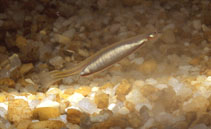| Family: |
Trichomycteridae (Pencil or parasitic catfishes), subfamily: Vandelliinae |
| Max. size: |
17 cm SL (male/unsexed) |
| Environment: |
demersal; freshwater |
| Distribution: |
South America: Amazon River basin. |
| Diagnosis: |
|
| Biology: |
Enters the gill cavity of larger fish to suck blood; burrows in sandy bottoms. Known to enter the urethra of humans urinating under water; presumably it mistakes the urea for water exhausted from gills. When inactive, it remains buried in soft, muddy bottom. Active both during daytime and at night while foraging for blood (Ref. 50921). Uses visual and chemo-sensory orientation to find potential hosts (Ref. 50919, 50921). Forces itself under the gill cover of host fish to enter gill chamber during ventilation of the latter. Bites mostly at the ventral or dorsal aorta arteries, and the blood is pumped into its gut by the host's blood pressure. It does not need any special sucking or pumping mechanism to quickly engorge itself with blood, but simply uses its needle-like teeth to make an incision in an artery. Thus, the notion of the blood-sucking candiru is a misleading concept. Able to engorge itself enormously, the ingested blood is visible through the swollen belly. Some kind of valve or sphincter is likely present to prevent reflux of ingested blood. Time required to engorge itself with blood and leave host’s gill chamber ranges from 30 to 145 seconds. Some host fish species (Colossoma macropomum) are able to hamper candiru’s attacks by pressing it under the membranous gill-cover flap, or by using its pectoral fin to press it against the flank or to sweep it from the gill-cover edge (Ref. 50921). |
| IUCN Red List Status: |
Least Concern (LC); Date assessed: 09 December 2020 Ref. (130435)
|
| Threat to humans: |
traumatogenic |
Source and more info: www.fishbase.org. For personal, classroom, and other internal use only. Not for publication.
